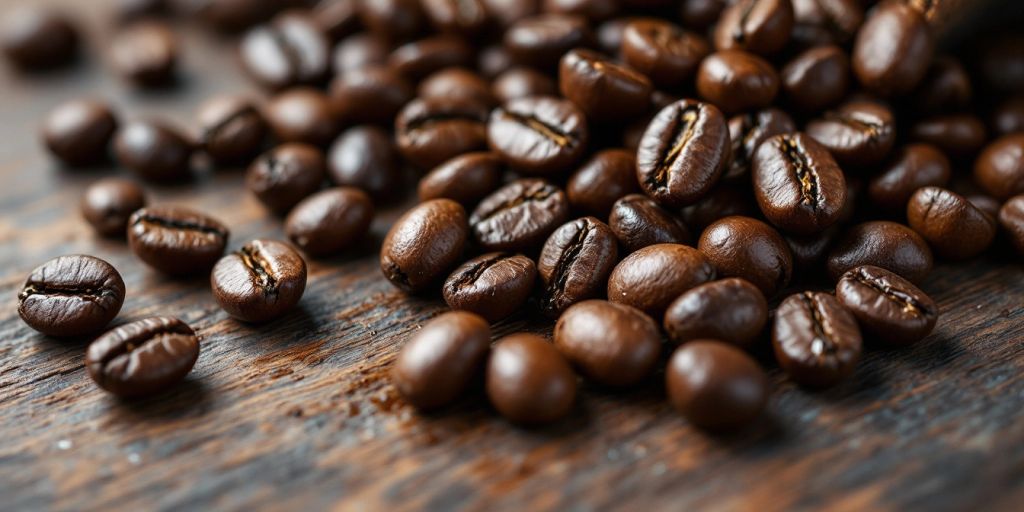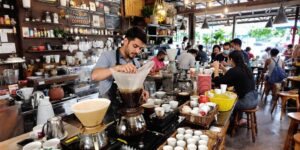The Origins of Roasted Coffee Beans
Cultivating Coffee Plants in the Coffee Belt
The journey of coffee begins in the Coffee Belt, a tropical region where coffee plants thrive. Here, farmers carefully cultivate two main types of coffee: Arabica and Robusta. Each type has its unique flavor profile and growing conditions.
- Arabica: Known for its smooth taste and lower caffeine content, it grows best at higher altitudes.
- Robusta: This type is hardier, with a stronger flavor and higher caffeine, thriving at lower altitudes.
The Importance of Climate and Altitude
Climate and altitude play a crucial role in the quality of coffee beans. Ideal conditions include:
- Temperature: Consistent warmth helps the cherries ripen evenly.
- Rainfall: Adequate water is essential for healthy growth.
- Altitude: Higher elevations often produce beans with more complex flavors.
Hand-Picking Coffee Cherries
Harvesting coffee cherries is a labor-intensive process. Farmers often hand-pick the cherries to ensure only the ripest ones are selected. This method is vital for maintaining quality and flavor. Freshly picked cherries are then processed to extract the beans, setting the stage for the next steps in the coffee journey.
The journey from farm to cup is not just about coffee; it’s about passion, tradition, and the love for a perfect brew.
Each step in this process contributes to the rich flavors we enjoy in our cups today. Understanding these origins enhances our appreciation for every sip we take, making coffee more than just a drink—it’s a lifestyle.
Processing Coffee Beans: From Cherry to Green Bean
Once the coffee cherries are harvested, they embark on an exciting journey to become the green beans we know and love. This transformation is crucial for flavor! Here’s how it works:
Dry Processing Method
In this method, the cherries are spread out under the sun to dry. This allows the fruit to impart its natural sweetness to the beans. The steps include:
- Drying: Cherries are laid out in the sun, turning them regularly.
- Hulling: Once dried, the outer husk is removed to reveal the beans.
Wet Processing Method
The wet method is all about cleanliness and brightness in flavor. Here’s how it goes:
- Pulping: The outer skin of the cherries is removed.
- Fermentation: The beans are soaked in water to break down the mucilage.
- Washing: Finally, the beans are washed to remove any remaining residue.
Impact of Processing on Flavor
The way coffee beans are processed has a significant impact on their flavor profile. For instance:
- Dry-processed beans often have fruity and complex notes.
- Wet-processed beans tend to have a cleaner, brighter taste.
The journey of a coffee bean is not just about the end product; it’s about the art and science behind each step, ensuring that every cup of espresso is a delightful experience.
Understanding these methods helps coffee lovers appreciate the rich flavors in their cup, making each sip a celebration of the journey from farm to cup!
The Art and Science of Coffee Roasting
Roasting coffee is where the magic happens. It’s the moment when green coffee beans transform into the aromatic delights we crave. This process is a blend of science and art, requiring skill to create the perfect cup.
Understanding Roast Levels
Roast levels can be categorized into three main types:
- Light Roast: Retains the original flavors of the bean, often fruity or floral.
- Medium Roast: Balances acidity and body, creating a well-rounded flavor.
- Dark Roast: Develops bold flavors, with notes of chocolate and caramel.
| Roast Level | Roasting Time | Roasting Temperature |
|---|---|---|
| Light | 5-7 minutes | 356–401°F (180–205°C) |
| Medium | 8-10 minutes | 410–428°F (210–220°C) |
| Dark | 11-14 minutes | 464–482°F (240–250°C) |
Chemical Changes During Roasting
During roasting, several chemical reactions occur:
- Drying: Moisture evaporates from the beans.
- Browning: The beans change color and develop flavor.
- Caramelization: Sugars in the beans caramelize, enhancing sweetness.
The challenge of roasting coffee is to find the right balance of acidity, body, and sweetness. This balance is crucial for a great cup.
The Role of the Roaster
A skilled roaster must understand how to control time and temperature to bring out the best in each batch. This is where the art of roasting shines, as each bean has its unique characteristics that can be highlighted or muted based on the roasting process.
Roasting is not just about heat; it’s about passion and precision. With the right techniques, anyone can create a cup of coffee that’s truly special, showcasing the rich flavors of roasted coffee beans.
Grinding Coffee Beans for Optimal Flavor
Different Grind Sizes for Various Brewing Methods
When it comes to coffee, grind size matters! Each brewing method requires a specific grind size to unlock the best flavors. Here’s a quick guide:
- Coarse Grind: Perfect for French press, allowing full immersion and a bold taste.
- Medium Grind: Ideal for drip coffee makers, balancing flavor and strength.
- Fine Grind: Best for espresso, ensuring a rich and concentrated shot.
The Importance of Consistent Grinding
Consistency is key! Uneven grinds can lead to over-extraction or under-extraction, ruining your coffee experience. Here are some tips for achieving a consistent grind:
- Use a burr grinder for uniformity.
- Adjust the grind size based on your brewing method.
- Grind just before brewing to preserve freshness.
How Grind Size Affects Extraction
The grind size directly impacts how water extracts flavors from the coffee. A finer grind increases surface area, leading to quicker extraction, while a coarser grind slows it down. This balance is crucial for achieving the perfect cup!
"Grinding coffee is crucial, as it increases the surface area, allowing water to extract the flavors more efficiently."
In summary, understanding the grind size and its impact on flavor can elevate your coffee experience. Enjoy the journey from bean to cup!
Brewing Techniques to Savor Roasted Coffee Beans

Brewing coffee is an art that brings out the rich flavors of roasted beans. Each method highlights different aspects of the coffee, making it essential to choose the right technique for your taste. Unlock the full potential of your coffee with these popular brewing methods:
Pour-Over Method
- What it is: A manual brewing technique where hot water is poured over coffee grounds in a filter.
- Why it’s great: This method allows for precise control over water flow and temperature, resulting in a clean and flavorful cup.
- Equipment needed: Coffee dripper, filter, carafe or mug.
French Press Technique
- What it is: Coffee grounds are steeped in hot water before being pressed through a metal filter.
- Why it’s great: This method produces a full-bodied, rich coffee with a robust flavor.
- Equipment needed: French press, coffee grinder.
Espresso Brewing
- What it is: A concentrated coffee made by forcing hot water through finely ground coffee under high pressure.
- Why it’s great: This method creates a strong shot of coffee with a rich crema on top, perfect for coffee lovers.
- Equipment needed: Espresso machine, grinder.
Brewing coffee is not just about making a drink; it’s about creating an experience. Each method offers a unique way to enjoy the flavors of roasted coffee beans.
To brew the perfect cup, remember the golden ratio: one to two tablespoons of ground coffee for every six ounces of water. This simple guideline can elevate your coffee experience!
From Farm to Cup: The Journey of Roasted Coffee Beans
Every cup of coffee tells a story, a tale that begins far from your kitchen. [The journey of a coffee bean](https://kiboko.coffee/blogs/news/the-journey-of-a-coffee-bean-from-farm-to-cup?srsltid=AfmBOooyAZL8g4JJIpjtrI9OVoNdXwHzTlMpz4Qc7tJMD03xr6tAmxvx) is a fascinating adventure that takes it from the lush farms to your favorite mug. Let’s explore this exciting path!
Global Coffee Supply Chain
- Farmers: They nurture coffee plants in the Coffee Belt, ensuring the cherries are ripe for picking.
- Processing: After harvesting, cherries are processed to extract green beans, using methods like dry or wet processing.
- Roasters: Green beans are roasted at high temperatures, transforming them into the aromatic, brown beans everyone knows and loves.
The Role of Wholesalers and Importers
- Wholesalers: They buy roasted beans in bulk, ensuring quality and consistency.
- Importers: They handle logistics, bringing beans from farms to roasters around the world.
- Quality Control: Each step ensures that only the best beans make it to your cup.
The Final Destination: Your Cup
- Brewing: The final act where ground coffee meets water, unlocking flavors and aromas.
- Enjoyment: Every sip is a celebration of the journey, connecting you to the farmers and roasters.
- Community: Coffee brings people together, creating bonds over shared experiences.
The journey of a coffee bean is not just about the drink; it’s about the people and passion behind it. Every cup is a reminder of the hard work and dedication that goes into crafting the perfect brew.
In conclusion, understanding this journey enhances our appreciation for coffee. So, the next time you sip your brew, remember the incredible path it took to reach you!
Exploring the Diverse Flavors of Roasted Coffee Beans

Coffee is not just a drink; it’s an experience that takes you on a flavorful journey. Each cup tells a story about where it comes from and how it was made. Let’s dive into the exciting world of coffee flavors!
Single-Origin vs. Blends
- Single-Origin Coffee: Comes from one specific location, showcasing unique flavors based on the region’s soil and climate. For example, Ethiopian coffee often has fruity and floral notes.
- Blends: A mix of different beans, crafted to create a balanced flavor profile. These can combine the best characteristics of various origins.
- Specialty Coffee: High-quality blends that highlight unique flavors, often made by expert roasters.
Flavor Profiles of Different Regions
| Region | Flavor Profile |
|---|---|
| Ethiopia | Fruity and floral |
| Colombia | Rich and chocolaty |
| Brazil | Sweet and nutty |
Specialty Coffee Varieties
- Light Roasts: Retain delicate flavors like floral and citrus.
- Medium Roasts: Offer a balanced, nuanced character.
- Dark Roasts: Develop bold flavors, often with chocolate and caramel notes.
Exploring different coffee varieties is a fantastic way to expand your coffee palate and discover hidden gems.
When you learn how to choose coffee beans, you open up a world of flavors waiting to be savored. Each cup is a new adventure!
Dive into the exciting world of roasted coffee beans! Each type offers a unique taste that can take your coffee experience to the next level. Whether you prefer a bold flavor or something smoother, there’s a perfect bean waiting for you. Don’t miss out on discovering your new favorite coffee! Visit our website to learn more about the amazing flavors of coffee beans and how to enjoy them!



